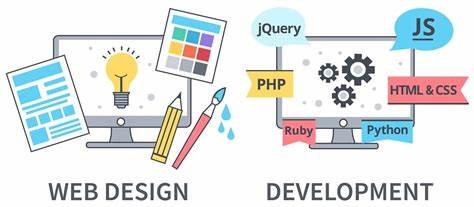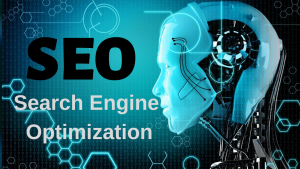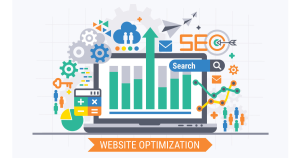Web Design and Development in 2025 empower businesses to build high-performing, user-friendly, and ROI-driven websites. Discover 10 proven ways Web Design and Development boost visibility, conversions, and brand success.

-
Introduction
-
Background: The Evolution of Web Design and Development
-
Why Web Design and Development Matter
-
The Core Framework: Design Meets Functionality
-
UX/UI Design Principles
-
Front-End and Back-End Development
-
Key Tools and Technologies
-
ROI and Business Impact
-
Future Trends
-
Conclusion
In the digital-first world of 2025, Web Design and Development are the cornerstones of online success. A well-crafted website defines your brand identity, drives engagement, and maximizes ROI. Businesses of all sizes — from startups to enterprises — depend on modern websites to attract customers, communicate value, and convert traffic into revenue.
Introduction
In the digital-first world of 2025, Web Design and Development are no longer optional — they’re essential pillars of brand identity, customer engagement, and revenue growth. Every business, from startups to global enterprises, relies on a strong online presence to connect with customers, showcase products, and establish trust.
Web Design focuses on creating visually appealing and user-friendly interfaces, while Web Development ensures the site functions smoothly, loads quickly, and performs across devices and browsers. Together, they form the foundation of a successful digital strategy.
In this comprehensive article, we will explore the history, principles, tools, technologies, and ROI impact of web design and development. You’ll discover how these two disciplines merge creativity and technology to build meaningful user experiences and high-performing business websites.
This content is written for business owners, entrepreneurs, digital marketers, and aspiring web professionals who want to understand how to design and develop websites that deliver measurable business value.
Background Information – The Evolution of Web Design and Development
The Early Days of the Web
The story of Web Design and Development began in 1991, when Tim Berners-Lee introduced the first website — a simple page of text with hyperlinks. At that time, websites were static, text-based, and purely informational.
From there, the internet rapidly evolved:
- 1990s (HTML Era): Early websites were static and coded manually in HTML.
- 2000s (Dynamic Web): CSS, PHP, and JavaScript enabled interactive, styled pages.
- 2010s (Responsive Design): Smartphones revolutionized website design, demanding mobile-friendly layouts.
- 2020s (Experience Design): UX/UI design, accessibility, and performance optimization define success.
Why Web Design and Development Matter Today

In today’s digital economy, your website is your virtual storefront — often the first impression of your brand. Statistics show that:
- 94% of first impressions are design-related.
- 75% of users judge a company’s credibility based on its website.
- Businesses with optimized web design and development see conversion rates 2–3x higher than competitors.
Whether you’re running an eCommerce store, SaaS business, or corporate website, professional Web Design and Development directly influences your brand’s ROI, engagement, and scalability.
Main Concepts – Understanding the Core of Web Design and Development
The Dual Framework: Design Meets Functionality
At its core, Web Design and Development combine creativity (design) and logic (development):
- Web Design focuses on aesthetics, layout, color schemes, branding, and user experience (UX/UI).
- Web Development ensures structure, functionality, and performance — using coding languages like HTML, CSS, JavaScript, and frameworks such as React or Laravel.
A successful website aligns form and function, meaning it not only looks good but performs efficiently and delivers measurable business results.
UX/UI Design: The User-Centric Approach
Modern web design emphasizes User Experience (UX) and User Interface (UI):
| Component | Focus | Goal |
| UX Design | User journey, usability, and satisfaction | Enhance engagement & reduce friction |
| UI Design | Visual layout, typography, colors | Ensure aesthetic appeal & clarity |
A user-first approach ensures visitors can navigate easily, trust the brand, and take action — whether it’s making a purchase, signing up, or requesting a demo.
Front-End and Back-End Development

Web Development has two core layers:
- Front-End (Client-Side): What users see and interact with — built using HTML, CSS, JavaScript, and frameworks like React.js or Vue.js.
- Back-End (Server-Side): What happens behind the scenes — databases, APIs, and server logic, often managed using PHP, Python (Django), Node.js, or .NET.
Together, these ensure a smooth, fast, and secure digital experience.
Key Tools and Technologies in Web Design and Development
In this section, we’ll explore five essential tools that power modern Web Design and Development — each playing a critical role in productivity, collaboration, and ROI.
H2-1: WordPress – Powering Over 40% of the Web
WordPress remains the world’s most popular CMS, empowering businesses to design and manage websites easily.
Features:
- Thousands of themes and plugins
- SEO-friendly architecture
- Easy content updates without coding
ROI Perspective:
WordPress lowers development costs by up to 60% and offers excellent scalability.
Example:
A retail brand migrated to WordPress, reducing annual maintenance costs by 45% while boosting site traffic through improved SEO performance.
H2-2: Webflow – Visual Design Meets Code

Webflow bridges the gap between design and development. Designers can visually create responsive websites without heavy coding.
Features:
- Visual drag-and-drop editor
- Built-in CMS and hosting
- Custom animations and interactions
ROI Perspective:
Webflow shortens project delivery time by up to 50%, enabling faster go-to-market for businesses.
Example:
A digital agency using Webflow reported doubling project output within a quarter while maintaining design quality.
H2-3: Figma – Collaborative Design for Teams

Figma is the leading tool for UI/UX design and prototyping, especially for remote teams.
Features:
- Real-time collaboration
- Component libraries for consistent design
- Cloud-based version control
ROI Perspective:
Figma enhances design efficiency, reducing revision cycles by 25–30%.
Example:
A fintech startup using Figma for web design improved design-to-development handoff speed by 40%, cutting project timelines significantly.
H2-4: React.js – The Front-End Powerhouse

React.js, developed by Facebook, is the most popular JavaScript library for building fast, scalable, and interactive web applications.
Features:
- Component-based architecture
- Virtual DOM for high performance
- Strong community support
ROI Perspective:
React.js ensures faster load times and smoother interactions, directly improving customer engagement and SEO.
Example:
An eCommerce platform built with React.js saw a 55% reduction in page load time and a 25% increase in conversions.
H2-5: Laravel – Streamlined Back-End Development
Laravel is a PHP-based framework known for its elegant syntax and robust security.
Features:
- MVC architecture
- Built-in authentication and security tools
- Easy database management
ROI Perspective:
Laravel reduces development costs and time through reusable components and clear code structure.
Example:
A logistics firm using Laravel reduced server errors by 40% and improved site reliability — leading to better client retention.
ROI, Strategy, and Real-World Applications of Web Design and Development
Measuring ROI in Web Design and Development
ROI from web design and development can be measured through:
| Metric | Description | ROI Impact |
| Conversion Rate | % of visitors taking desired action | Directly linked to design quality |
| Load Time | Website speed and responsiveness | Faster sites improve SEO & retention |
| Mobile Optimization | Compatibility across devices | Expands reach and user base |
| User Engagement | Time on site and page interaction | Reflects overall satisfaction |
ROI Insight:
Every second of website load delay reduces conversions by 7%. Investing in efficient design and development directly increases business performance.
Case Study: Redesign That Boosted Revenue
A SaaS company redesigned its website with a focus on UX/UI and code optimization. Results within 6 months:
- 50% faster loading speed
- 30% increase in lead conversions
- 40% higher retention among existing users
This demonstrates that strategic Web Design and Development aren’t expenses — they’re growth investments.
The Business Impact
Modern web design and development provide:
- Brand credibility: A professional website builds trust.
- Lead generation: Optimized sites convert visitors into customers.
- Scalability: Future-proof frameworks enable easy expansion.
- Global reach: Responsive design connects businesses with worldwide audiences.
Future Trends in Web Design and Development

- AI-Powered Personalization: Websites will adapt dynamically based on user behavior and preferences.
- Voice Search Optimization: Integration of voice-enabled navigation.
- Progressive Web Apps (PWAs): Blending app-like experiences with web accessibility.
- Headless CMS: Faster, API-driven development.
- Sustainability in Web Design: Energy-efficient websites with green hosting.
These innovations redefine how websites deliver personalized, efficient, and ethical digital experiences.
Conclusion
The Power of Web Design and Development
Web Design and Development form the foundation of digital success. They represent a perfect blend of creativity, functionality, and strategy — enabling brands to stand out, perform better, and grow faster.
Whether it’s a startup seeking visibility or an enterprise optimizing conversions, investing in modern web design and development brings measurable ROI through improved usability, scalability, and customer trust.
Your website is not just an online brochure — it’s a digital ecosystem that influences how your audience perceives and interacts with your brand.
H2: Call to Action – Build a Website That Converts
Ready to transform your digital presence? Partner with a professional web design and development team to craft a website that not only looks stunning but delivers measurable business growth.


